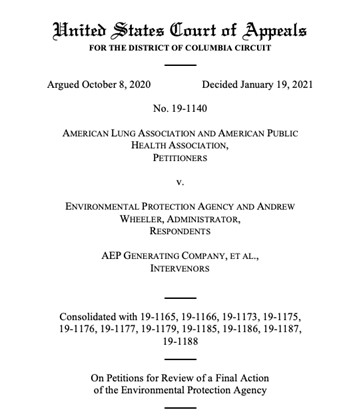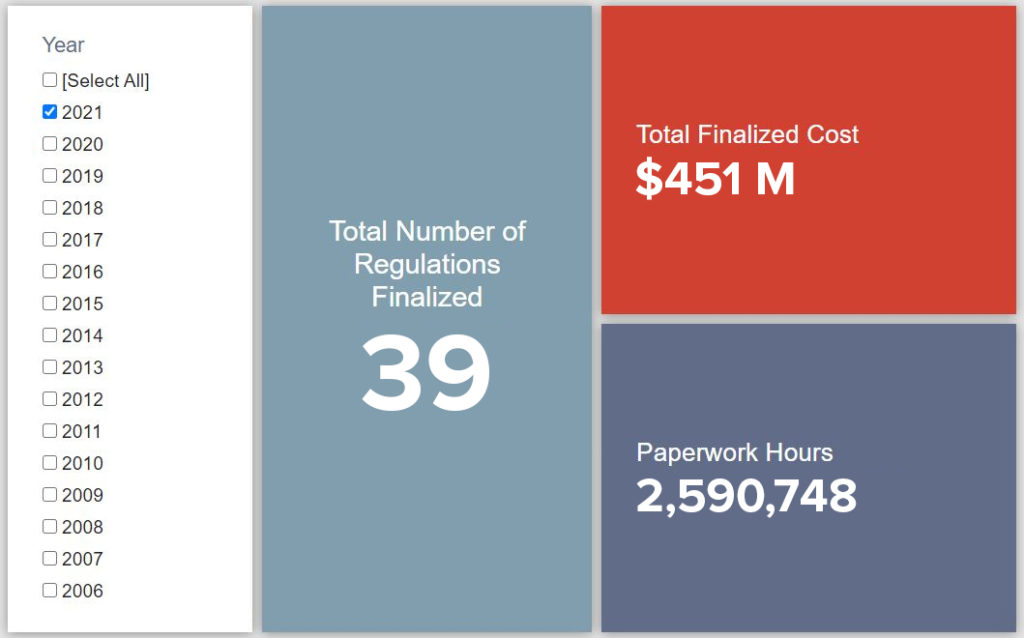Week in Regulation
January 25, 2021
The Regulatory State Shifts
Last week, of course, marked the transition from the Trump Administration to the Biden Administration. This marks an end to the cost-cutting mindset and regulatory budget of the Trump era. Indeed, the most notable rulemaking was a deregulatory proposal from the Department of Health and Human Services (HHS) that now has a very tenuous future – if any future at all. Across all rulemakings, agencies published $8 billion in total net cost savings and cut 12.1 million hours of annual paperwork.
REGULATORY TOPLINES
- Proposed Rules: 32
- Final Rules: 42
- 2021 Total Pages: 6,817
- 2021 Final Rule Costs: $451 million
- 2021 Proposed Rule Costs: -$8.2 billion
WRAPPING UP THE REGULATORY BUDGET
On Inauguration Day, President Biden signed an executive order (EO) repealing (among others) EO 13,771, ending the era of regulatory budgeting. Thus, through last Tuesday agencies will have published 80 deregulatory actions and 35 regulatory actions (as defined by EO 13,771), totaling $33.9 billion in quantified total net costs in what would have been the fiscal year 2021 budgetary window.
The broader contours of a Biden Administration’s approach to regulatory policy are still developing, but a memo on “Modernizing Regulatory Review” gives some sense of what lies ahead. Further analysis of that can be found here. Also, as expected, agencies are under a “regulatory freeze” while the new administration gets a handle on where various rulemakings stand. This could have implications for some rules recently promulgated under the Trump Administration.
NOTABLE REGULATORY ACTIONS
As noted earlier, the highlight of the week was a proposed rule from HHS regarding “Proposed Modifications to the HIPAA Privacy Rule To Support, and Remove Barriers to, Coordinated Care and Individual Engagement.” The proposal seeks “to modify the Standards for the Privacy of Individually Identifiable Health Information (Privacy Rule) under the Health Insurance Portability and Accountability Act of 1996 (HIPAA) and the Health Information Technology for Economic and Clinical Health Act of 2009 (HITECH Act),” in order to make it easier for individuals to access and share their medical information with relevant health care providers. HHS estimates that this could yield roughly $556 million in net annualized savings (or $8.1 billion in present value).
This proposal’s timing and status are rather unique. It officially hit the pages of the Federal Register on January 21, despite clearly being a Trump Administration initiative. This is likely due to some odd technical quirk in how the Office of the Federal Register processed it. Regardless, as a proposed rule, it is now at the mercy of the Biden Administration. Considering its sizable deregulatory impact, one may expect it to be on the chopping block. Given the measure’s potential implications for such areas as mental health and substance abuse treatment and telehealth arrangements in the age of COVID-19, however, this may be a candidate for the incoming administration to revise and amend rather than simply cut loose.
THIS WEEK’S REGULATORY PICTURE
This week, a federal court strikes down the Trump Administration’s Affordable Clean Energy (ACE) rule.

It was a busy week for executive branch activity. The Trump Administration concluded with a flurry of midnight regulation and the Biden Administration set about undoing many of its predecessor’s actions. But overshadowed by the transition of the presidency was a federal court striking down the ACE rule.
The rule, issued by the Environmental Protection Agency (EPA) in 2019, repealed the Obama Administration’s Clean Power Plan (CPP) and set new efficiency standards for coal-fired power plant. The crux of the ACE rule was that the Obama Administration’s EPA had erred in its reading of the Clean Air Act, and incorrectly structured the CPP to allow for requirements beyond those limited only to on-site fixes at power plants.
On January 19, the U.S. Court of Appeals for the D.C. Circuit disagreed. It found the Trump Administration EPA’s reading of the Clean Air Act faulty, and its rule arbitrary and capricious. It vacated the rule and remanded it back to the EPA.
The upshot of the ruling is that it expedites the ability of the Biden Administration EPA to promulgate its own rule on greenhouse gas emissions from power plants, which will likely be more like the CPP. Had the ACE rule remained in effect, EPA would have had to go through the rulemaking process to repeal it and replace it. With the Court of Appeal’s ruling, it no longer needs to justify repealing the ACE rule.
While that is good news for the Biden Administration, reimplementing the CPP is no slam dunk. That rule was put on pause by a federal court before the end of the Obama Administration, so the legal outcome of the rule is unknown. It could be that the CPP itself went beyond the scope of the Clean Air Act.
TOTAL BURDENS
Since January 1, the federal government has published $7.7 billion in total net cost savings (with $451 million from finalized rules) and 8.9 million hours of net annual paperwork burden reductions (with 2.6 million hours in increases from final rules).












